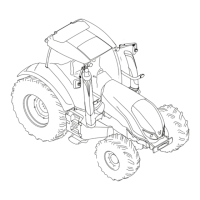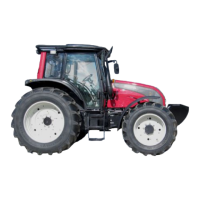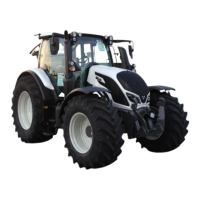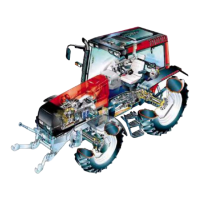What to do if Hydraulic Oil Temperature High on Valtra Tractor?
- SSamantha ShieldsAug 2, 2025
If the hydraulic oil temperature is high on your Valtra Tractor, stop the engine, clean the hydraulic oil cooler, and check the hydraulic oil level.

What to do if Hydraulic Oil Temperature High on Valtra Tractor?
If the hydraulic oil temperature is high on your Valtra Tractor, stop the engine, clean the hydraulic oil cooler, and check the hydraulic oil level.
What to do if Hydraulic Oil Level Low on Valtra Versu N Tractor?
If the hydraulic oil level is low on your Valtra Tractor, stop the engine and check the hydraulic oil level. Add oil if needed.
What does 'SLOW DOWN HIDASTA' mean on Valtra Versu N?
If you see the message 'SLOW DOWN HIDASTA' on your Valtra Tractor, slow down. The buzzer will stop and the display will return to normal once the transmission speed decreases sufficiently.
What to do if STOP indicator light starts flashing on Valtra Tractor?
If the STOP indicator light starts flashing on your Valtra Tractor, stop the tractor and the engine immediately. Continue only in an emergency, for example, to move the tractor to the roadside.
What to do if book symbol starts flashing on Valtra Versu N Tractor?
If the book symbol starts flashing on the tractor terminal display of your Valtra Tractor, contact an authorised Valtra workshop immediately.
What does Low Fuel Pressure mean on Valtra Versu N Tractor?
This message about low fuel pressure on your Valtra Tractor gives information about the pressure drop of the fuel before running faults appear.
What to do if the limiting function of the maximum engine speed is on Valtra Versu N Tractor?
Avoid long-term and heavy use of the engine on your Valtra Tractor until the error is fixed.
| Engine Type | AGCO Power |
|---|---|
| Transmission | PowerShift |
| Hydraulic System | Load Sensing |
| PTO Speed | 540/1000 rpm |
| Engine | 4-cylinder |
Defines hazard notification types: DANGER, WARNING, CAUTION, IMPORTANT, NOTE used in documentation.
General rules for safe operation, maintenance, and handling of the tractor and its components.
Covers maintaining hardware safety, using safety features, and general safe operating practices.
Details the single key system for tractor locks and identifies the clutch, brake, and drive pedals.
Overview of dashboard components including steering wheel, levers, instrument panels, and switches.
Explains the control panel for display selection and the Proline instrument panel features.
Details symbols and indicator lights on the Proline panel for various tractor functions.
Location and function of controls on the right side, including tractor terminal, driving controls, and linkage.
Identifies controls located on the rear side of the cab, such as window latches and wipers.
Describes controls located on the left side of the tractor, including storage and lighter.
Lists controls on the right-hand side roof console, including radio and air conditioning.
Details controls for the Skyview equipment's right-hand side roof console.
Explains the operation of various working light controls and their automatic functions.
Covers controls for automatic and manual air conditioning and additional heater systems.
Instructions for adjusting air-suspended and Valtra Evolution operator seats for comfort and ergonomics.
Identifies controls located on the rear mudguards.
Describes controls and connections at the front of the tractor.
Details rear controls and connections located outside the cab.
Guidelines for the initial 50 operating hours to ensure longevity and economy.
Steps to ensure proper tractor handling, maintenance, and preparation before use.
Procedures for starting the tractor under normal, cold, and auxiliary battery conditions.
Instructions on operating various lights, including headlights and working lights.
How to use turn signals, horn, and rotary beacon lights.
Operation of heater, air conditioning systems, and defrost.
Information on lighter, current sockets, and trailer sockets.
Comprehensive guide to driving operations, including steering, power shuttle, and parking brake.
Information on tractor terminal, Proline instrument panel, and A-pillar display.
Details the various fixed and selectable views on the Proline display.
Information about the A-pillar display and its control panel.
Overview of the tractor terminal, its keypad, and navigation through menus.
Comprehensive guide to operating rear linkage controls like lifting, lowering, and draft control.
Instructions for attaching implements, adjusting lift links, and using quick couplings.
Details on auxiliary hydraulic controls, functions, and connections.
Guidance on using the front linkage, including settings and connections.
Information on using and adjusting the pivoting front linkage and Valtra LHLink system.
Instructions for operating the Valtra front loader, coupling devices, and softdrive.
Procedures for attaching implements and operating rear and front PTOs.
Guide to U-Pilot controls, operating requirements, programmes, and error codes.
Information on connecting implements via signal connectors and resetting connections.
Details on the ISOBUS system, terminals, connectors, and power supply.
Information on installing and using the Auto-Guide 3000 steering system.
Covers pick-up hitches, drawbars, and towing device frames.
Information on the tractor's air pressure system for external purposes.
Factors affecting trailer compatibility, turn signals, air brakes, and hydraulic brake valve.
Options for running hours-based or annual maintenance schedules and their procedures.
Requirements for service inspection on new tractors for guarantee retention.
General instructions and precautions for performing maintenance tasks safely.
Guidelines for correct fuel usage, storage, and recommended lubricants.
Procedures for storing the tractor for periods shorter or longer than two months.
Steps for running the tractor after short-term or long-term storage.
Overview of periodical maintenance schedules and charts.
Procedures for checking and adjusting various tractor components and systems.
Instructions for changing tyres, checking pressures, and adjusting turning angles.
Guidance on adjusting front and rear axle track widths for optimal performance.
Precautions and usage guidelines for installing and using wheel chains.
Information on using twin-mounted wheels for reduced surface pressure.
Procedures related to the engine, including bleeding the fuel system.
Safety precautions and procedures for the electrical system, including fuses and relays.
Maintenance and checks related to the tractor's power transmission system.
Instructions for adjusting and calibrating the steering system angle.
Procedures for cleaning cab ventilation air filters and adjusting mudguards.
Calibration and adjustment procedures for the Valtra LHLink system.
Maintenance guidelines for pick-up hitches, jaws, and drawbars.
Guidance on interpreting indicator lights and acting on error situations and service codes.
Lists common warnings on the Proline panel and recommended actions.
How to identify blocked filters based on indicator lights and system behavior.
Instructions for reading active service codes displayed on the tractor terminal.
How to access and view the tractor's IO list for detailed information for service personnel.
Explains fault codes indicated by the Valtra LHLink button's blinking light.
Troubleshooting steps for steering system malfunctions, including loss of hydraulic supply.
Detailed procedures and precautions for towing the tractor with or without the engine running.
Provides detailed measurements and dimensions of the tractor, including cab height and wheelbase.
Lists total, front, and rear axle masses for different models.
Details permissible axle loads, considering driving speed and off-road conditions.
Specifies the maximum permissible towable masses for various braking configurations.
Explains tyre markings and provides a table of tyre parameters.
Lists flange distances for front and rear axles, and mudguard clearances.
Tables detailing front and rear axle track widths for adjustable discs and fixed discs.
Specifications for the engine, including model, designation, type, and boost.
Overview of the electrical system, including voltage, battery, alternator, and fuse/relay counts.
Details on the power shuttle, clutch, gearbox, and PTO specifications.
Technical specifications of the tractor's brake system, including multi-disc brakes and trailer brake systems.
Information on the hydrostatic steering system, including working pressure and pump capacity.
Specifications for cab filter capacity, windscreen washer, air conditioning, noise level, and vibration exposure.
Detailed specifications for hydraulic circuits, including valve types and oil volumes.











